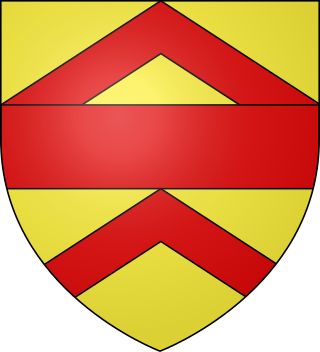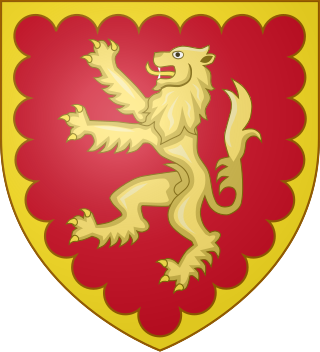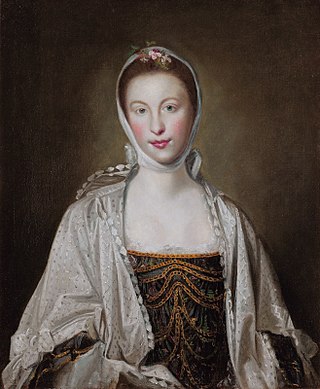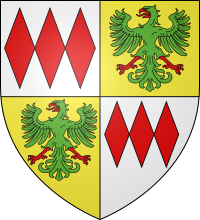
Baron Mowbray is a title in the Peerage of England. It was created by writ for Roger de Mowbray in 1283. The title was united with the Barony of Segrave in 1368, when John Mowbray, 1st Earl of Nottingham and 5th Baron Mowbray succeeded to that title, and in the next generation, the Baron Mowbray was named Duke of Norfolk. With the childless death of Anne Mowbray, 8th Countess of Norfolk in c.1481, the Barony went into abeyance between the Howard and Berkeley families, and both styled themselves Baron Mowbray and Seagrave.

Earl of Salisbury is a title that has been created several times in English and British history. It has a complex history, and is now a subsidiary title to the marquessate of Salisbury.

Baron FitzWalter is an ancient title in the Peerage of England. It was created on 24 June 1295 for Robert FitzWalter. The title was created by writ, which means that it can descend through both male and female lines. His great-grandson, the fourth baron, was an Admiral of the Fleet. The fourth baron's grandson, the sixth baron, died from dysentery at the siege of Harfleur. He was succeeded by his brother, the seventh baron, who was the last known male line descendant of Rollo of Normandy, and was succeeded by his daughter and only child, Elizabeth. She was the wife of John Radcliffe. Their son, the ninth baron, was attainted for treason in 1495 with his title forfeited. However, his son Robert Radcliffe obtained a reversal of the attainder by Act of Parliament in 1509 and later served as Lord Lieutenant of Lancashire. He was created Viscount FitzWalter in 1525 and Earl of Sussex in 1529. His grandson, the third earl, was summoned to the House of Lords through a writ of acceleration in 1553 in his father's junior title of Baron FitzWalter. Lord Sussex later served as Lord Deputy of Ireland. He was succeeded by his younger brother, the fourth earl. He had earlier represented Maldon, Hampshire and Portsmouth in the House of Commons and also served as Lord Lieutenant of Hampshire. When he died the titles passed to his only child, the fifth earl. He was Lord Lieutenant of Essex.

Baron Stafford, referring to the town of Stafford, is a title that has been created several times in the Peerage of England. In the 14th century, the barons of the first creation were made earls. Those of the fifth creation, in the 17th century, became first viscounts and then earls. Since 1913, the title has been held by the Fitzherbert family.

Baron le Despencer is a title that has been created several times by writ in the Peerage of England.

Baron Hungerford is a title in the Peerage of England. It was created on 7 January 1426 for Walter Hungerford, who was summoned to parliament, had been Member of Parliament, Speaker of the House and invested as Knight of the Order of the Garter before and was made Lord High Treasurer one year before he became a peer. The man who would later succeed as third baron was created Baron de Moleyns on 13 January 1445 by writ of summons; both titles merged when he succeeded as Baron Hungerford in 1459. The third baron was attainted and the peerage forfeit in 1461. This attainder was reversed in 1485 for the then 4th baroness of Hungerford, and so it came into the Hastings family of Earls of Huntingdon until 1789, when it came into the Rawdon(-Hastings) family of the Marquesses of Hastings until 1868 when it fell into abeyance. This abeyance was terminated three years later for a member of the Abney-Hastings family and an Earl of Loudoun. In 1920 it again fell into abeyance, which was terminated one year later for the Philipps family of the Viscounts of St Davids where it has remained since.

The title of Viscount Lisle has been created six times in the Peerage of England. The first creation, on 30 October 1451, was for John Talbot, 1st Baron Lisle. Upon the death of his son Thomas at the Battle of Nibley Green in 1470, the viscountcy became extinct and the barony abeyant.
The title Baron Ferrers of Chartley was created on 6 February 1299 for John de Ferrers, son of Robert de Ferrers, 6th Earl of Derby. The daughter of the 6th Baron Ferrers of Chartley, Anne, married Walter Devereux who was summoned to parliament as Lord Ferrers in her right. Their descendants became Earls of Essex and the peerage was forfeited in 1601 on the attainder of Robert Devereux, 2nd Earl of Essex, but restored to his son Robert in 1604, on whose death in 1646 the peerage fell into abeyance. The abeyance was terminated in 1677 when Robert Shirley, a grandson of one of the sisters of the 3rd Earl of Essex, was summoned as Lord Ferrers of Chartley with precedence to the original creation. In 1711, Shirley was created the 1st Earl Ferrers, but the Earldom and Barony separated at his death, the barony going to Elizabeth Shirley, the daughter of his eldest son, while the earldom went to his second son. On the 1741 death of Elizabeth Shirley, 15th Baroness Ferrers of Chartley and wife of the Earl of Northampton, the peerage again briefly fell into an abeyance that was resolved in 1749 by the death of two of the three heiresses, leaving the surviving daughter, Charlotte Compton, wife of the Marquess Townshend, as 16th Baroness Ferrers of Chartley. The barony continued, merged with the marquessate, until the death of George Ferrars Townshend, 3rd Marquess Townshend in 1855, when it again fell into abeyance between his two sisters and their heirs. It remains in abeyance.
Alice Montagu was an English noblewoman and the suo jure 5th Countess of Salisbury, 6th Baroness Monthermer, and 7th and 4th Baroness Montagu, having succeeded to the titles in 1428.
The title Baron Monthermer was created twice in the Peerage of England.
Elizabeth Frances Philipps, Viscountess St Davids was a British peeress. Following the passing of the Peerage Act 1963, she became the first woman to take her seat in the House of Lords by virtue of an hereditary peerage as 14th Baroness Strange of Knokin.
Cecily Neville, Duchess of Warwick, Countess of Worcester was a daughter of Richard Neville, 5th Earl of Salisbury and Alice Montacute, 5th Countess of Salisbury. Her siblings included Richard Neville, 16th Earl of Warwick; John Neville, 1st Marquess of Montagu; George Neville, ; Katherine Neville, Baroness Hastings; and Alice Neville, Baroness FitzHugh.

John Montagu, 3rd Earl of Salisbury and 5th and 2nd Baron Montagu, KG was an English nobleman, one of the few who remained loyal to Richard II after Henry IV became king.

Thomas Montagu, 4th Earl of Salisbury, KG of Bisham in Berkshire, was an English nobleman and one of the most important English commanders during the Hundred Years' War.
Edward Montagu, 1st Baron Montagu was an English peer. He fought at the Battle of Crecy. His assaulted his first wife, Alice of Norfolk, who died as a result.

Elizabeth Rawdon, Countess of Moira in the Peerage of Ireland was a literary patron and antiquarian; she also held five English peerages in her own right. She was born at Donington Park, Leicestershire, England and died at Moira, County Down, Ireland.
Alice Neville, Baroness FitzHugh was the wife of Henry FitzHugh, 5th Baron FitzHugh. She is best known for being the great-grandmother of queen consort Catherine Parr and her siblings, Anne and William, as well as one of the sisters of Warwick the 'Kingmaker'. Her family was one of the oldest and most powerful families of the North. They had a long-standing tradition of military service and a reputation for seeking power at the cost of the loyalty to the crown as was demonstrated by her brother, the Earl of Warwick.

John de Montacute was a 14th-century English nobleman and loyal servant of King Edward III. He was the son of William Montagu, 1st Earl of Salisbury by his wife Catherine Grandison, and younger brother of William de Montacute, 2nd Earl of Salisbury (1328–1397). He also had several younger sisters.

The House of Montagu ( MON-tə-ghew; historically Montagud, Montaigu, Montague, Montacute and Litinised as de Monte Acuto is an English noble family founded in Somerset after the Norman Conquest of 1066 by the Norman warrior Drogo de Montagud. They rose to their highest power and prominence in the 14th and 15th centuries as Earls of Salisbury, the last in the male line being Thomas Montagu, 4th Earl of Salisbury, the maternal grandfather of "Warwick the King-Maker", 16th Earl of Warwick, 6th Earl of Salisbury.











